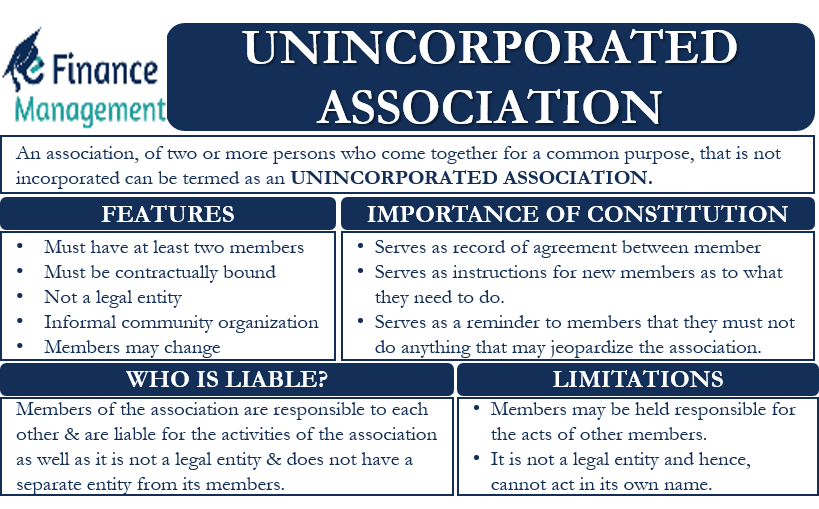An Unincorporated Association, as the word suggests, is a corporation that is not incorporated. It is basically an association of members who come together/are associated for a common purpose. So, a group of people who agree to work together for a common purpose can be termed as an unincorporated association.
Each member of the association has mutual duties and obligations. And every such association has its own rules and regulations for its smooth operations. Also, if members want, they may form a committee of a few members to manage the operations of the association.
Moreover, such associations can be for carrying out commercial activities (for profit) or charitable activities (non-profit). Since such an association is not incorporated, it is not a legal entity. Thus, if anyone wants to transfer any assets to an association, it can not legally do so. Transfer of assets to one or more of its members is the only alternative in such a situation.
Examples of such associations are local sports clubs, drama clubs, investment clubs, and more.
Features of Unincorporated Association
Following are the features of an unincorporated association:
- All such associations must have at least two members.
- The members of the association must be contractually bound by the rules, or the association must have rules.
- It is not a legal entity.
- These are generally small or informal community organizations.
- Members of such an association may change from time to time like any other incorporated association.

Process of Forming Unincorporated Association and Importance of Constitution
To form such an association, all one needs to do is write a constitution. Moreover, one needs to get the consent of other members to the constitution. Among other things, the constitution must clearly state the objective of the association.
Also Read: Limited Liability Company
It is very important to have a constitution as it serves as a written record of what was agreed between the members. Moreover, it serves as instructions for new members as to what they need to do.
Since all members are responsible for the association’s activities, the constitution serves as a reminder to members that they must not do anything that may jeopardize the interest of the association.
A constitution mainly includes the following three things:
- The constitution must include the rules and eligibility for becoming a member. And the circumstances that may lead to the end of the membership.
- If an association plans to have a committee to manage the association, then the constitution must state how the election of committee members will happen. It must also lay down the powers and responsibilities of the committee members. And how their appointment ends.
- Over time, members may feel that the rules are not up to date and impeding the growth of the association. Thus, they want to change them. So, the constitution must clearly lay down requirements for changing the rules, such number of votes.
Who is Liable?
The biggest difference between an incorporated and unincorporated association is that while the incorporated association gets the status of a legal entity. This is, however, not so in the case of an unincorporated association. Unlike a company, an unincorporated association is not a legal entity. Moreover, such an association does not have a separate entity from its members. Thus, members of the association are responsible for each other and are liable for the activities of the association as well.
So, if an association carries out commercial activities, then any contact on behalf of the association needs to be in the name of one or more members. Or, if the association has a committee, then it needs to enter into a contract. Also, a point to note is that if an association has a committee, then it is generally the committee that is liable for the association’s activities.
Also Read: Corporation
Limitations of Unincorporated Association
Since the association does not get the status of a legal entity, this becomes the major drawback of forming such an association. Because in such a situation for any issues, all the members may become responsible for the acts of other members. So, the safest way to run such an association is to make rules and responsibilities as clear as possible. Also, the guidelines must clearly state how the association will work and carry out its operations.
Another limitation is that since an association is not a legal entity, there are several things it can not do. These things include borrowing money, holding assets, starting legal action, and entering contracts. However, the members of the association can do all such activities, on behalf of the association, in their names.
Final Words
An unincorporated association has many advantages over a company structure, such as it gives operational flexibility, very few rules and regulations, and it does not need to go through a long and complicated process for each and everything, and more. However, it hinders the growth of the association beyond a certain point by retaining the same structure. The preferred course would therefore be is to go for the incorporation of the association. This will enable members to make and deliver various decisions and steps for the growth of the association.
Frequently Asked Questions (FAQs)
1. Must have at least two members
2. Members must be contractually bound by the rules
3. Not a legal entity
4. Members may change from time to time
To form an unincorporated association, one needs to write a constitution. And get the consent of other members to the constitution. It must clearly state the objective of the association. It also lays down the powers and responsibilities of the committee members. And how their appointment ends.

